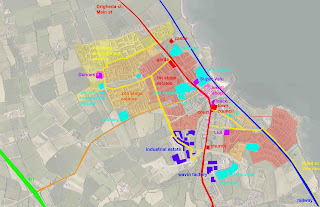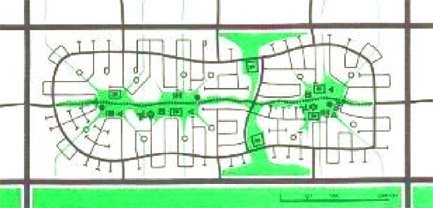This report outlines the work carried out by the NowWhat Remaking the Modern Suburb Project in 2010 including:
- Literature review and urban analysis of the town of Balbriggan
- On street and online survey results.
- Map of Balbriggan from a pedestrian or public transport user's perspective.
- Case studies of potential interventions to address problems with permeability.
Monday, January 10, 2011
Thursday, August 6, 2009
Balbriggan - DRAFT - Analysis of Housing Development and Key Sites
Balbriggan

Some links from Tzvetelina on Balbriggan
Hello everyone,
I thought I should mention these websites for anyone interested in Balbriggan-
http://www.balbriggan.net/
http://www.balbriggan.ie/
http://en.wikipedia.org/wiki/Balbriggan
http://www.dublintourist.com/towns/balbriggan/
http://www.balbrigganhistory.net/
And on the funny side ... this summer Balbriggan made it to the Tv news with this story - customers take over pub and throw out the staff !!!
In German Suburb, Life Goes On Without Cars
Check out this article from the NYTimes on Vauban in Germany. They've put all the cars in a big garage at the edge of the neighbourhood. The streets are then redesigned for living. Also, as people have to walk at least a short distance to get the car they are encouraged to keep walking or cycle instead of taking out the car. There's a slideshow of photos too.
The Smallest Metropolis...

Here's a look at suburbs from a completely different angle in Japan...
James Leahy
The Smallest Metropolis... (Entered May. 11, 2009) Random Musings...
A city planner of a new town had a radical idea. 'Streets' he said, cost money, take time to build, cause pollution, and are ugly, so let's build a city without them!
The other members scoffed at this. 'A city needs streets' they said. This has been a sad fact of life since the beginning of civilization. How do you propose to have a functioning city without streets?'
'Hmm' the radical thinker thought for a minute. 'Got it! Let's put everyone in the city in one big building!' He leaned back in his chair with his hands behind his head and a smile on his face. Most of the other planners were convinced, and suitably impressed with his cleverness, but there were still a few dissenters.
'How are we going to convince people to come live in the middle of the countryside, in a town with only one building!' They cried. 'People who move to the countryside want to live in houses!'
'Easy' he said slyly. 'We market it to city folk who want to live surrounded by nature, but not actually touch it. We'll let 'em know they can be one with nature without having any contact with things like pesky bugs, smelly animals or dirty farmers. Oh, and the view will be grand.'
The dissenters tried to find some flaw in his logic, but it was impeccable, so the smallest metropolis in the world was built.
Sitting in the middle of nowhere, Fukushima (correction: the building is actually in Yamagata), surrounded by picturesque mountains and fields, one can only wonder what the occupancy rate is. At 41 floors, it's taller than most buildings in Tokyo.
However if the town does continue to grow (up, not out), it'll be interesting to see how they manage to fit in things like a baseball stadium and an airport....
Saturday, July 25, 2009
Mapping/Re-Mapping
In her lecture on Friday 24th, Finola O'Kane described how the artist Fisher used pictorial representation to re-present the Irish Landscape to potential tourists in the late 1700s. The paintings made certain areas more popular to visit as tourists flocked to see the view made in Fisher's paintings. Landowners became conscious of this, and started to preserve these views, and therefore the landscape around them.
Re-presenting or re-mapping a city/town to its inhabitants (eg: the london cycle route map) is an effective way of changing how it is used.
Re-presenting or re-mapping a city/town to its inhabitants (eg: the london cycle route map) is an effective way of changing how it is used.
Subscribe to:
Posts (Atom)




+Plan+for+Motorized+Suburb.jpg)


